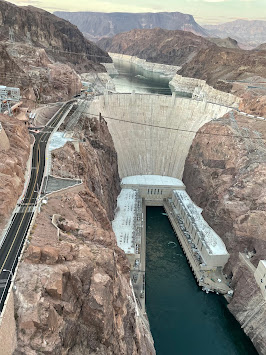Well, the COVID pandemic derailed several trips these past two years, and for the second summer in a row, I wasn't able to go on my narwhal expedition. But never fear! I'm still learning about the environment and doing some traveling this summer!
 |
| See the "bathtub ring" in Lake Mead? Highlights the water level that is at an all-time low |
 |
| Buddies with the President, much? Oh, not that one? This other one? |
On another free evening, my new friends and I went into Las Vegas to walk around the casinos and see the sights. I'll be honest - it was weird seeing so many unmasked people, but it was fun seeing the Strip with the new eyes of people who've never been before!
 |
| With my new pals Jessica, Travis, Catherine, Derek, and Jeanne |
On another free day, Jessica, Derek, Travis and I hiked Red Rock Canyon - a lovely respite from the heat. Since it is at a slightly higher elevation, it was only about 85°... downright chilly after a week in 115° weather!
On the hottest day of the trip, (yes, unfortunate planning), we traveled to the Valley of Fire for a day hiking through the park. Despite the heat, it was a stunning place with cool rock formations and petroglyphs.
After my two weeks in Boulder City, I decided to take the long route back home, camping and visiting several natural wonders with my cousin Evelyn.
First stop was Cathedral Gorge, one of Nevada's state parks. This place is a true hidden gem, with some of the most remarkable geologic features that I've ever seen. A million years ago, the area was covered by a freshwater lake, which deposited a layer of silt. Over the years, rain and melting snow carved gullies and fissures into the siltstone, creating thin canyons known as caves. Unlike the slot canyons found in other areas of the Colorado Plateau, these aren't caused by flash floods, so many were so thin that we had to shimmy through sideways and ended in dead ends.
Next was Great Basin NP, one of the least-visited units of all the National Parks. I'd always wanted go, but thought of it as basically being in the middle of nowhere (it's on the far east side of Nevada, bordering Utah - but it's only 4 1/2 hrs from Las Vegas and less than 4 from Salt Lake City - totally worth the drive).
One of the most famous things about Great Basin is its night sky - because of its high elevation and low light pollution, it is supposed to be amazing for stargazing. Unfortunately, the week we were there, the Bootleg Fire in eastern Oregon combined with other wildfires on the West Coast blew so much smoke that the haze blocked out much of our night sky. Another victim of climate change :( Hot weather also meant no campfires... did you know you can cook smores on a frying pan?
 |
| Me, with my new 3,500 year old pal! |
At the end of the trip, we also hiked through the Methuselah Grove in the White Mountains of the Eastern Sierras, where the current oldest tree, Methuselah, is found (but the exact location is kept a secret since you know there are awful people that would damage or destroy it!) Climate change is also threatening the bristlecones - warming temperatures are allowing other species to move into their territory, competing for the already scant resources.
 |
| The Methuselah Grove, in the White Mountains. |
To get home, we drove across Nevada along Hwy 50 - known as the 'loneliest road in America.' Nevada's tourism board really did a great job marketing this road, and it was decidedly NOT lonely. Several historical towns such as Ely, Eureka, Austin, and Fallon are found along the route, making it an interesting and enjoyable drive.
Hwy 50 partly follows the former route of the Pony Express - the horse-mounted mail service that ran for 18 months during 1860-61.
 |
| Sand Springs Pony Express Station - in the background you can see the large sand dune that curiously appears in the middle of the Great Basin |
Back in California, we hiked Lundy Canyon through one of the most amazing wildflower blooms that I've ever seen. In one field of tall Sierra Larkspur, the hummingbirds were so numerous you could hear them chirping and buzzing all around!
The COVID pandemic has caused many people to go outside, and while I've heard that the National Parks are overcrowded, Great Basin is so remote that we didn't really see the throngs of people that other parks might face. But when we got to Devil's Postpile National Monument, we found the crowds.
 |
| Rainbow Falls |
The postpile is an interesting geologic feature created when a 400-foot deep pool of molten lava formed parallel cracks to relieve pressure as it cooled. Later, a glacier moved over it, carving and polishing the top. You can easily see the hexagonal formations formed by the cooling lava, and the glacial striations marking the direction where the formation was rubbed. This can clearly be seen from the top of the postpile, so I found it odd that when we got to the top, we were the only ones there. Given how many people were crowding onto the bus to get into the park, you'd think there'd be a huge throng trying to see this natural wonder. After talking to the park ranger, we found out that most people don't bother hiking to the top, even though it isn't a very long detour. While I'm glad more people are trying to get out to enjoy nature, I do think some people actually need to be taught how to appreciate nature...














No comments:
Post a Comment